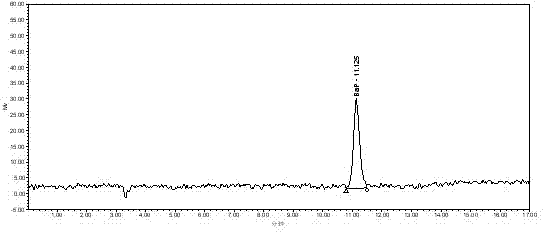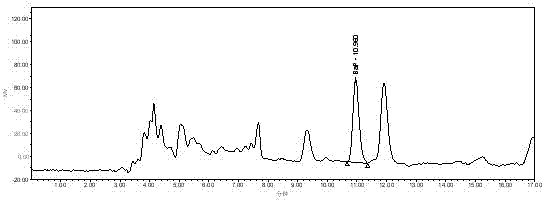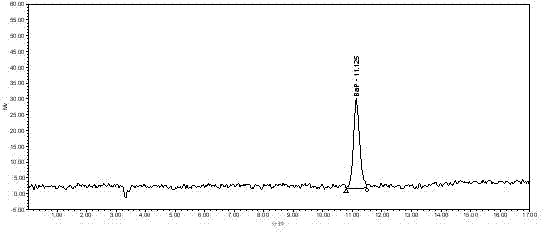Determination method of benzo(a)pyrene in Camellia oleifera seed oil
A technology of Camellia oleifera seed oil and a detection method, which is applied in the direction of measuring devices, instruments, scientific instruments, etc., can solve the problems of large influence of environmental factors, high requirements for neutral alumina, and difficulty in ensuring reproducibility, so as to achieve a small impact on the external environment , the effect of accurate quantitative analysis
- Summary
- Abstract
- Description
- Claims
- Application Information
AI Technical Summary
Problems solved by technology
Method used
Image
Examples
Embodiment 1
[0030] 1) Weigh 1.5g of Camellia oleifera seed oil sample (known to contain 12.0±0.5μg / kg of benzo(a)pyrene) into a 25mL triangular flask, add 90mL of 3mol / L potassium hydroxide ethanol solution, at 75 ℃ water bath condensation reflux saponification 1h;
[0031] 2) Take out the saponification solution and cool it, pour all the saponification solution into a 500mL separatory funnel, add 50mL saturated sodium chloride solution, add petroleum ether (100mL, divided into 3 times), shake vigorously, and extract 3 times;
[0032] 3) Combine the extracts in a 250mL separatory funnel, wash with ultrapure water until neutral, filter the petroleum ether phase through anhydrous sodium sulfate into a 250mL ground-mouth round-bottom flask, and rotate it to dryness in a water bath at 40°C , add 2mL of petroleum ether to obtain the extract, to be purified;
[0033] 4) Activate the neutral alumina purification column (250mg, 3mL) with 5.0mL petroleum ether first, the flow rate is about 2.0mL / ...
Embodiment 2
[0038] 1) Weigh 3g of Camellia oleifera seed oil sample (known to contain 8.0±0.2μg / kg of benzo(a)pyrene) into a 25mL ground-mouth Erlenmeyer flask, add 100mL of 2.5mol / L potassium hydroxide ethanol solution, at 85 ℃ water bath condensation reflux saponification 1.5h;
[0039] 2) Take out the saponification solution and cool it, pour all the saponification solution into a 500mL separatory funnel, add 80mL saturated sodium chloride solution, add petroleum ether (200mL, divided into 3 times), shake vigorously, and extract 3 times;
[0040]3) Combine the extracts in a 250mL separatory funnel, wash with ultrapure water to neutrality, filter the petroleum ether phase through anhydrous sodium sulfate into a 250mL ground-mouth round bottom flask, and rotate it to dryness in a water bath at 35°C , add 3mL of petroleum ether to obtain the extract, to be purified;
[0041] 4) Activate the neutral alumina purification column (250mg, 3mL) with 8.0mL petroleum ether first, the flow rate i...
Embodiment 3
[0046] 1) Weigh 5g of Camellia oleifera seed oil sample (known to contain benzo(a)pyrene 4±0.2μg / kg) into a 25mL grinding mouth Erlenmeyer flask, add 300mL, 1mol / L potassium hydroxide ethanol solution, at 100℃ Condensate in a water bath and reflux for saponification for 2 hours;
[0047] 2) Take out the saponification solution and cool it, pour all the saponification solution into a 500mL separatory funnel, add 100mL saturated sodium chloride solution, add petroleum ether (300mL, divided into 3 times), shake vigorously, and extract 3 times;
[0048] 3) Combine the extracts in a 250mL separatory funnel, wash with ultrapure water until neutral, filter the petroleum ether phase through anhydrous sodium sulfate into a 250mL ground-mouth round-bottom flask, and rotate it to dryness in a water bath at 45°C , add 1mL of petroleum ether to obtain the extract, to be purified;
[0049] 4) Activate the neutral alumina purification column (250mg, 3mL) with 10mL petroleum ether first, the...
PUM
 Login to View More
Login to View More Abstract
Description
Claims
Application Information
 Login to View More
Login to View More - R&D
- Intellectual Property
- Life Sciences
- Materials
- Tech Scout
- Unparalleled Data Quality
- Higher Quality Content
- 60% Fewer Hallucinations
Browse by: Latest US Patents, China's latest patents, Technical Efficacy Thesaurus, Application Domain, Technology Topic, Popular Technical Reports.
© 2025 PatSnap. All rights reserved.Legal|Privacy policy|Modern Slavery Act Transparency Statement|Sitemap|About US| Contact US: help@patsnap.com



